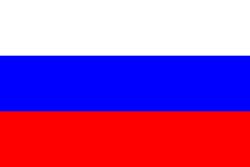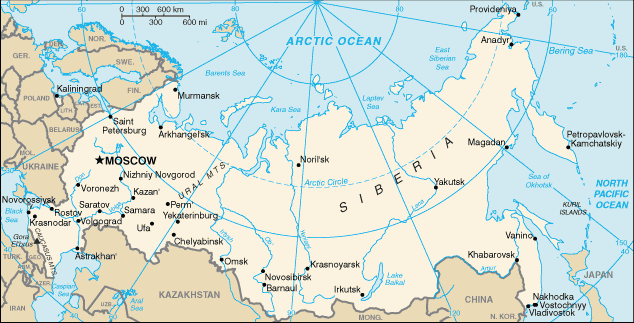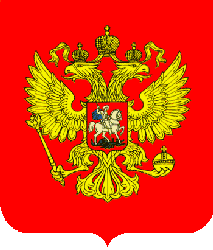Russian Federation
Related Categories:
 Flag of Russia
Flag of RussiaThree equal horizontal bands of white (top), blue, and red. |


|
In 1992 the last innovation in the Emblem came into force: the abbreviation above hammer and sickle was replaced by the inscription "Russian Federation".
www.rf.boom.ru/
Presentation of Russia, Description of the flag, Flag day, Origin of the flag, Supposed color meanings, Flag mourning, Flag related national anthem lyrics proposal.
www.fotw.us/
After the breakup of the Soviet Union, the newly-independent Russian Federation emerged as a great power and is also considered to be an energy superpower. Russia is internationally recognised as continuing the legal personality of the Soviet Union and is a permanent member of the United Nations Security Council.
en.wikipedia.org/
Most of the roughly 141 million Russians derive from the Eastern Slavic family of peoples, whose original homeland was probably present-day Poland. Russian is the official language of Russia and is one of the six official languages of the United Nations. Russian is also the language of such giants of world literature as Pushkin, Tolstoy, Dostoevsky, Chekhov, Pasternak and Solzhenitsyn.
Russia's educational system has produced nearly 100% literacy. About 3 million students attend Russia's 519 institutions of higher education and 48 universities, but continued reform is critical to producing students with skills to adapt to a market economy. Because great emphasis is placed on science and technology in education, Russian medical, mathematical, scientific, and space and aviation research is still generally of a high order. The number of doctors in relation to the population is high by American standards, although medical care in Russia, even in major cities, is generally far below Western standards. The unraveling of the Soviet state in its last decades and the physical and psychological traumas of transition during the 1990s resulted in a steady decline in the health of the Russian people. Currently Russia faces a demographic crisis as births lag far behind deaths. While its population is aging, skyrocketing deaths of working-age males due to cardiovascular disease is a major cause of Russia's demographic woes. A rapid increase in HIV/AIDS infections and tuberculosis compounds the problem. In 2007, life expectancy at birth was 59 for men and 73 for women. The large annual excess of deaths over births is expected to cut Russia's population by 30% over the next 50 years.
The Russian labor force is undergoing tremendous changes. Although well educated and skilled, it is largely mismatched to the rapidly changing needs of the Russian economy. Official unemployment has dropped in recent years to 6.9%, and labor shortages have started to appear in some high-skilled job markets. Nonetheless, pockets of high unemployment remain and many Russian workers are underemployed. Unemployment is highest among women and young people. Following the 1991 collapse of the Soviet Union and the economic dislocation it engendered, the standard of living fell dramatically. However, real disposable incomes have doubled since 1999, and experts estimate that the middle class ranges from one-fifth to one-third of the population. In 2006, 15.8% of the population lived below the subsistence level, in contrast to 38.1% in 1998.
Moscow is Russia's capital and largest city (population 8.3 million). Moscow is also increasingly important as an economic and business center; it has become Russia's principal magnet for foreign investment and business presence. Its cultural tradition is rich, and there are many museums devoted to art, literature, music, dance, history, and science, as well as hundreds of churches and dozens of notable cathedrals.
The second-largest city in Russia is St. Petersburg, which was established by Peter the Great in 1703 to be the capital of the Russian Empire as part of his Western-looking reforms. The city was called Petrograd during World War I and Leningrad after 1924. In 1991, as the result of a city referendum, it was renamed St. Petersburg. Under the tsars, the city was Russia's cultural, intellectual, commercial, financial, and industrial center. After Lenin moved the capital back to Moscow in 1918, the city's political significance declined, but it remained a cultural, scientific, and military-industrial center. The Hermitage, formerly the Winter Palace of the tsars, is one of the world's great fine arts museums.
Russia has an area of about 17 million square kilometers (6.5 million sq. mi.); in geographic terms, this makes Russia the largest country in the world by more than 2.5 million square miles. But with a population density of about 22 persons per square mile (9 per sq. km.), it is sparsely populated, and most of its residents live in urban areas.
www.state.gov/r/
Introduction
About
Contact
Symbols in The News
Interpret this Symbol
AAC
African
AI
Alchemy
Alphabets
Ancient
Animal Symbolism
Architecture
Art
Articles
Astrology
Baha'i
Blissymbolics
Blueprint Symbols
Buddhist
Celtic Symbols
Cemetery
Chinese Symbols
Christian
Circle
City
Codes
Color
Conlangs
Crop Circles
Danger
Da Vinci Code
Designing Logos
Dictionaries
Dreams
Education
Egyptian Symbols
Electrical
Emoticons
Find Images
Fonts
Food
Fraternity
Hamsa
Healing
Heraldry
Hermetic
Highway Signs
Hindu
History
Hobo
Holiday
Icons
iConji
Islamic
Jain Symbols
Japanese, Kanji
Jewish
Justice
Law
Literary Symbolism
Mandalas
Map
Masonic
Math, Number
Meaning of Names
Medical
Middle East
Military
Miscellaneous
Money
Music
Mythology
Native American
Playing Cards
Power
Psychology
QiQiiKhu
Reiki
Religious
Runes, Norse
Sacred Geometry
Scientific
Science Fiction
Sorority
Sports
Symbols in the News
Tattoos
ThirteenSymbols
Tree of Life
Ursprache
Videos
Visual Languages
Weather
Web Codes
Wicca
Words
Writing Systems
Braille
Coinherence
Coptic
Cuneiform
Easter Island
Etruscan
Happy Human
Hebrew
Kokopelli
Linear B
Lotus
Love Symbols
Mandorla
Moon Alphabet
Nine Pointed Star
Om
Oz
Phonetic
Scarab Beetle
Silent
Theosophy
Unifon
About
Contact
Symbols in The News
Interpret this Symbol
AAC
African
AI
Alchemy
Alphabets
Ancient
Animal Symbolism
Architecture
Art
Articles
Astrology
Baha'i
Blissymbolics
Blueprint Symbols
Buddhist
Celtic Symbols
Cemetery
Chinese Symbols
Christian
Circle
City
Codes
Color
Conlangs
Crop Circles
Danger
Da Vinci Code
Designing Logos
Dictionaries
Dreams
Education
Egyptian Symbols
Electrical
Emoticons
Find Images
Fonts
Food
Fraternity
Hamsa
Healing
Heraldry
Hermetic
Highway Signs
Hindu
History
Hobo
Holiday
Icons
iConji
Islamic
Jain Symbols
Japanese, Kanji
Jewish
Justice
Law
Literary Symbolism
Mandalas
Map
Masonic
Math, Number
Meaning of Names
Medical
Middle East
Military
Miscellaneous
Money
Music
Mythology
Native American
Playing Cards
Power
Psychology
QiQiiKhu
Reiki
Religious
Runes, Norse
Sacred Geometry
Scientific
Science Fiction
Sorority
Sports
Symbols in the News
Tattoos
ThirteenSymbols
Tree of Life
Ursprache
Videos
Visual Languages
Weather
Web Codes
Wicca
Words
Writing Systems
Braille
Coinherence
Coptic
Cuneiform
Easter Island
Etruscan
Happy Human
Hebrew
Kokopelli
Linear B
Lotus
Love Symbols
Mandorla
Moon Alphabet
Nine Pointed Star
Om
Oz
Phonetic
Scarab Beetle
Silent
Theosophy
Unifon
